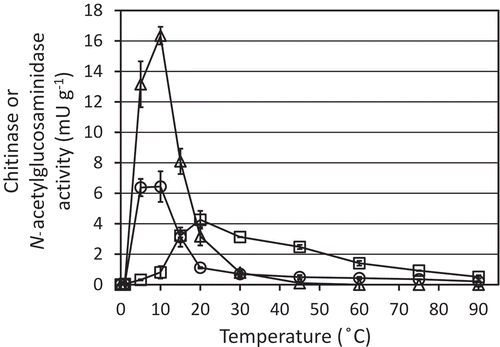Figures & data
Table 1. Selected physicochemical properties of the air-dried Brown Forest soil examined in this study.
Figure 1. Analysis of soil with or without chitin powder by thermogravimetry. (A) Alteration of relative weight (dashed lines) and rate of decline in weight (normal line) with or without chitin powder. The contents of chitin added to soil (g kg−1) are also indicated. (B) Relationship between the maximum rate of decline in weight and chitin content. The averages of triplicate measurements are plotted. Error bars indicate standard deviations. The result of linear approximation is shown by a formula with its correlation coefficient. ***p < 0.001.
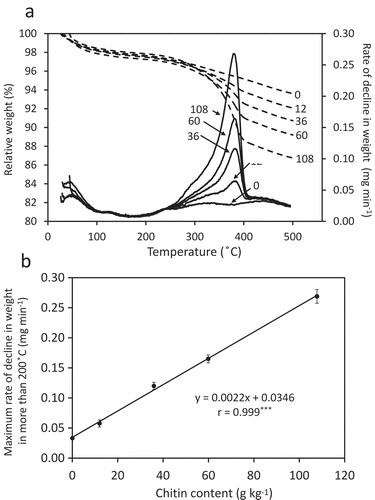
Figure 2. Thermogravimetric analysis of soil supplemented with cellulose or chitosan powder (A) and with N-acetylglucosamine (GlcNAc) or N,N'-diacetylchitobiose [(GlcNAc)2] (B) in comparison that with chitin powder. Rates of decline in weight are plotted. The content of each supplement added to soil was set to 60 g kg−1.
![Figure 2. Thermogravimetric analysis of soil supplemented with cellulose or chitosan powder (A) and with N-acetylglucosamine (GlcNAc) or N,N'-diacetylchitobiose [(GlcNAc)2] (B) in comparison that with chitin powder. Rates of decline in weight are plotted. The content of each supplement added to soil was set to 60 g kg−1.](/cms/asset/98b353b9-853c-4a50-9914-357003a5ccc0/tssp_a_1457408_f0002_b.gif)
Figure 3. Thermogravimetric analysis of the soil incubated at 25°C after adding chitin. Alteration of relative weight (dashed lines) and rate of decline in weight (normal line) of the soil samples (A) and chitin contents determined based on the maximum rates of decline in weight (B). The logarithmic scale version of panel B is shown in (C). In panel A, days after the addition of chitin are indicated. In panels B and C, averages of triplicate measurements for the duplicate samples are plotted. Error bars indicate standard deviations of total six measurements. The result of exponential approximation is shown with the formula and correlation coefficient in panel C. The dotted line in panel B has drawn according to the approximation formula obtained in C. ***p < 0.001.
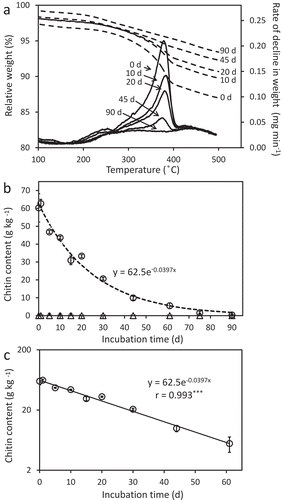
Figure 4. Total carbon (A) and total nitrogen (B) contents, and carbon/nitrogen ratio (C/N ratio) (C) in soil with (circles) or without (triangles) the addition of chitin powder. Soil was incubated at 25°C for 90 days after adding chitin. Soil samples were prepared in duplicate. Averages of duplicate measurements are plotted. Error bars indicate the maximum and minimum values obtained in the duplicate measurement. The dashed line in panel A indicates the estimated total carbon contents that were calculated by adding the carbon contents in the remaining chitin to the initial measured total carbon content.
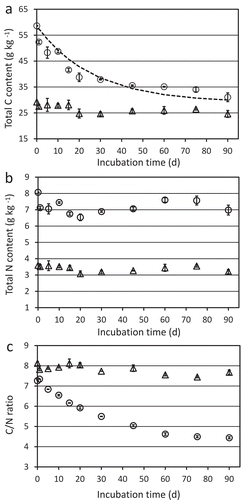
Figure 5. Ammonium (A), nitrite (B), and nitrate (C)-nitrogen contents, and pH (D) in soil with (circles) or without (triangles) the addition of chitin powder. Soil was incubated at 25°C for 90 days after adding chitin. Soil samples were prepared in duplicate and the average values are plotted. Error bars indicate the maximum and minimum values obtained in the duplicate measurement. The dashed line in panel A indicates the estimated NH4+-N contents that were calculated from the measured chitin contents under the hypothesis that all the degraded chitin-N is accumulated as NH4+-N in the soil. pH was measured in water (soil:water = 1:2.5).
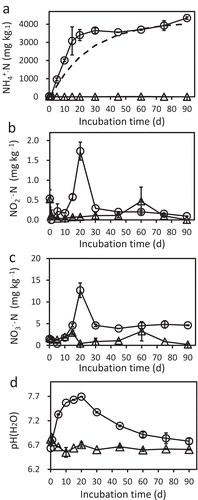
Figure 6. Chitinase (circles and triangles) and N-acetylglucosaminidase (squares) activities in the extracts from chitin-added soil. Chitinase activity was measured by using 4-methylumbelliferyl (MU)-(GlcNAc)2 (circles) or 4MU-(GlcNAc)3 (triangles), while N-acetylglucosaminidase activity was measured with 4MU-GlcNAc. Soil samples were prepared in duplicate and the average enzymatic activities are shown. Error bars indicate the maximum and minimum activities of the duplicated soil samples.
